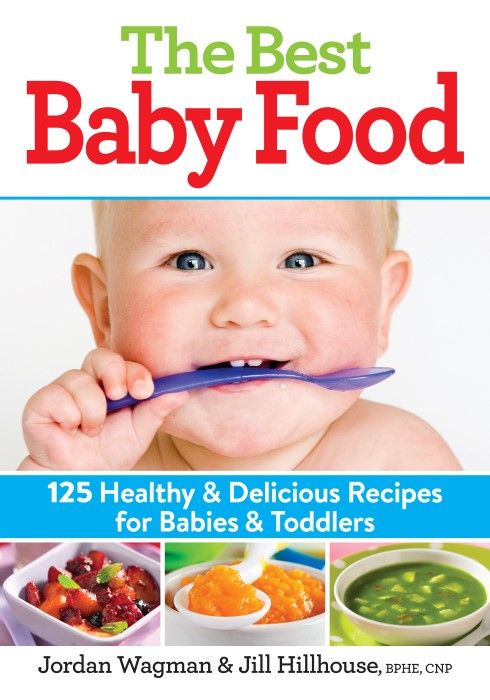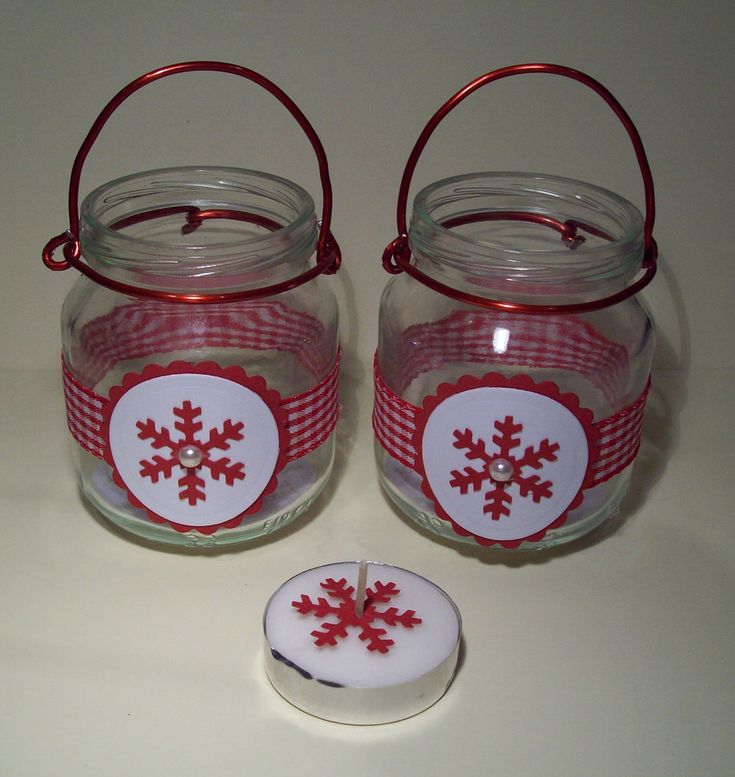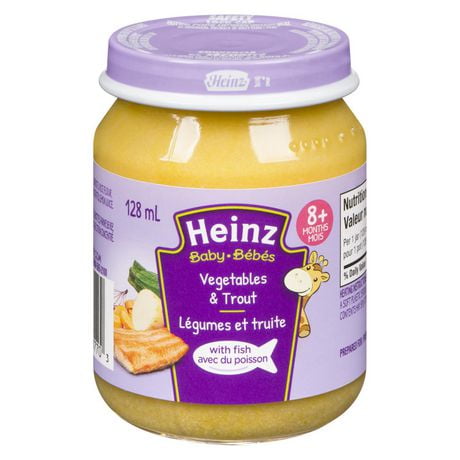Baby parrot food list
How To Take Care of A Baby Parrot (from Hatchling To Juvenile)
Caring for baby parrots (chicks) is a rewarding experience, but it requires knowledge and commitment. Baby parrots shouldn’t be purchased until they’ve been weaned to avoid health complications.
Once weaned, baby parrots should be fed soft seeds, fruits, and vegetables until they’re old enough to eat pellets and dried seeds.
They must be kept at a temperature of 65 to 85 degrees Fahrenheit.
When choosing a cage, ensure the bar spacing isn’t too wide. Provide perches of varying widths and position them throughout the cage.
Wild parrots care for their young for at least a year, which involves more than feeding as parrots teach their chicks how to become independent.
Parrot Growth Stages
There are five development stages of a baby parrot’s growth:
- Neonate (hatchling)
- Nestling
- Fledgling
- Weanling
- Juvenile (pre-adolescent)
Neonate
During the first stage of life, newly-hatched parrots are born with closed eyes. They’re also naked, blind, and deaf, so they depend on their owners.
In the wild, hatchlings are fed food that their parents regurgitate. Without a mother and father, owners must give chicks a special hand-rearing formula through a syringe.
Nestling
When the parrot reaches the nestling stage, it opens its eyes but remains dependent on its owners.
Imprinting occurs during stage two. When the chick first opens its eyes, it bonds deeply with its parents. If another parrot isn’t present, the baby parrot will imprint on its human owner.
This stage is vital for development, as it needs visual, touch, and sound stimulation.
Fledgling
The fledgling stage is when a parrot begins to learn how to fly.
Some parrots start to lose weight as they’re more preoccupied with flying than eating. As a result, they’re dependent on their owners or parents for food.
Once the parrot has learned how to fly, it’s a good time to clip its wings. However, doing so too early will prevent a parrot from learning to fly.
Wing clipping partially stops a parrot from flying away and protects it from dangers around the house, such as windows, ovens, and ceiling fans.
Weanling
In the weanling stage, parrots consume solid foods independently. Weaning parrots begin to forage and develop skills that allow them to care for themselves.
Juvenile
Parrots become pre-adolescent birds and can fend for themselves. They’ll be on solid food without the need for formula. They’ll be independent of their parents but won’t have reached sexual maturity yet.
At this stage, juvenile parrots won’t have their full adult color. This develops after the molting season, so don’t be alarmed if your baby parrot doesn’t look how you’d expect it to.
The parrot should be at least 8 to 12 weeks old before it’s given a new home.
What Do You Feed Baby Parrots?
Hagen Avicultural Research Institute artificially incubated psittacine eggs, and babies without parents must be hand-fed for 3-5 months.
To do this, mix your chosen hand-rearing formula in boiled water that’s been allowed to cool. Stir all the lumps and bumps to form a smooth, thickened mixture.
When hand-feeding baby parrots, the temperature of the food must be below 45°C before feeding; if the food is under 40°C, there’s a risk of it fermenting and causing infection.
However, most chicks will be cared for by their parents during their initial life stages. Get parrots that have been weaned, as hand-feeding has complications that can compromise the parrot’s health.
Once the parrot has reached the weaning stage, it needs seeds and vegetables. Safe foods include:
- Soaked and sprouted seeds
- Cooked sweet corn kernels
- Soft vegetables
- Fresh fruits
- A selection of greens, including chickweed and dandelion leaves
It takes a while for a baby parrot’s digestive system to become robust enough to cope with dried seeds and pellets. However, leaving a small dish of pellets that parrots can forage through is safe.
Also, ensure a shallow bowl of fresh water is left in its cage.
Baby parrots shouldn’t be fed water orally as they can drown. They receive hydration through regurgitated foods and hand-rear formula, so they only need water bowls once they move onto solid foods when they’re around 4 weeks old.
Baby Parrot Feeding Schedule
According to VCA Hospitals, how much and often you feed the baby parrot depends on its age and growth rate. Young birds need regular feeding and eat more often than older birds.
The following guidelines set out how much food the average baby parrot needs. All feeding should be carried out between 6 am and midnight:
- 1-2 weeks: Feed 6-10 times daily, every 2-3 hours.
- 2-3 weeks: Feed 5-6 times daily, every 3-4 hours.
- 3-4 weeks: Feed 4-5 times daily, every 4 hours. The bird can be put into a cage with a low perch and a shallow water bowl at four weeks old.
- 5-6 weeks: Feed twice daily.
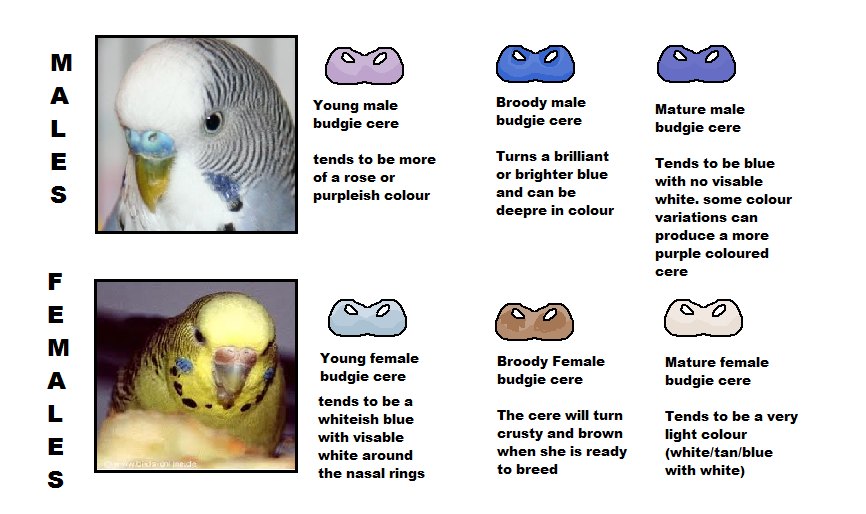 Soft seeds, fruits, veggies, and pellets can be put in the cage.
Soft seeds, fruits, veggies, and pellets can be put in the cage. - 7 weeks: Place the bird in a large cage with pellets in cups scattered across the floor.
- 8 weeks: The weaning process should be started. Then, provide nutritionally complete pellets.
After feeding, examine the crop. While the bird has few feathers, you can see when it’s full. However, an examination using the thumb and index finger can also help you check the crop’s fullness.
Healthy parrots should respond well to every feed, and the crop should empty between feedings. They should also produce regular droppings.
How To Keep A Baby Parrot Warm
When a parrot is old enough to live in a cage, the ideal temperature is 65-85 degrees Fahrenheit. Temperatures below 40 degrees are dangerous for birds and can cause health problems.
Similarly, temperatures above 85 degrees cause heat stress, and parrots also need appropriate ventilation to remain cool and comfortable.
However, keeping young chicks warm is more complicated, as even the slightest temperature change can be fatal. However, in the absence of parents, you’ll need to provide the baby parrot warmth to ensure it survives. To do so, follow these steps:
Make A Brooder
You’ll need a container for the parrot to live in. Commercial brooders are expensive, but you can easily make one with a fish tank or plastic container. Opt for metals or plastics that are easy to sanitize.
Choose a brooder that allows the parrot to move about as it grows.
Fill It with Substrate
You’ll need to cover the floor of the container with a substrate. Small parrots do well with folded-up newspaper on the bottom of the brooder, but you can use paper towels.
Avoid wood shavings or cat litter, as curious chicks will try to eat it.
Heat The Brooder
If you’re using a commercial brooder, it’ll already have a thermostatically controlled heating function.
If you’ve made your own, you’ll need to line it with a heat mat. Ensure your chosen heat source has a thermostat so you can amend the temperature.
Ensure your chosen heat source has a thermostat so you can amend the temperature.
You can also use a desk lamp set up over the brooder, which uses a red bulb that won’t disturb the chicks. The temperature inside the brooder should be:
- 1-5 days: 96°F
- Days 5-10: 95°F
- From 10 days until they’ve developed some feathers: 91°F
- When they’ve most of their down feathers: 84-89°F
- When the wings and head are mostly covered by feathers: 78-82°F
Once the chick reaches 3 to 4 weeks of age, it can regulate its body temperature.
At this stage, you can remove the heat source. To keep a baby parrot warm, ensure the room the parrot lives in is maintained at the right temperature.
Do Baby Parrots Sleep A Lot?
The majority of parrots are either tropical or subtropical.
They live near the equator, which gets 12 hours of darkness each night. So, parrots are awake from sunrise to sunset and need between 12 to 14 hours of uninterrupted sleep each day.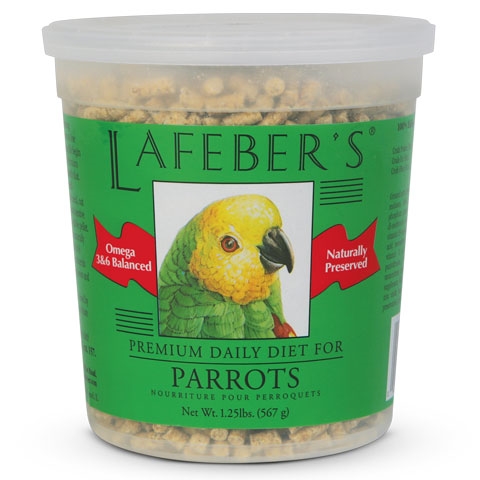
Baby birds need more than this as they’re growing and developing. Although it’s hard to know how often they’ll sleep, chicks will rest as much as they need to.
It’s not uncommon for baby parrots to only wake up when they’re being fed, sleeping at all other times of the day until they’re older and stronger.
How To Set Up A Parrot Cage
Parrots live in cages from around the age of 7 weeks.
Because they’re still growing, selecting a cage that’ll provide enough room for your parrot to be comfortable when it’s fully grown is important.
Follow these cage setup tips to get started:
Determine the Space of the Bars
Parrots can get their heads stuck or escape from cages with bars set too wide apart. You shouldn’t risk it if you’re out of the house and can’t supervise it constantly.
- Small parrots, like conures, need bars spaced ¾ inch apart.
- Medium-sized birds, like parakeets and cockatiels, need bars spaced ½ inch apart.
- Large parrots, like Amazons and Macaws, need 1 inch between the bars.

Find a cage that allows a parrot to roam freely without too much restriction.
Perches
Parrots are always on their feet, even while sleeping. Therefore, perches are an essential part of the cage’s setup. In the wild, trees and branches provide resting spots of all shapes, sizes, and widths.
Allowing your parrot to adjust its feet to the widths of the perches ensures that it stays supple and flexible, preventing health problems later.
Rope perches can be adapted to fit the cage. Also, add a Pedi perch to the cage so your parrot can keep its claws filed down and its beak under control.
When adding perches to the cage, space them out so the cage doesn’t become crowded. Parrots prefer high perches and tend to ignore all others in the cage.
To start with, place the perches around the mid-level of the cage to allow your parrot to get used to them. Then, move them higher once the parrot has settled and the perches feel familiar.
Food and Water Bowls
Most cages come with at least one food and water tray.
However, with trays that rest on the bottom of the cage, it’s easy for parrots to drop empty seed husks back into it, especially while learning how to forage.
This leads to a risk of starvation, so it’s a good idea to put a couple of upright feeders in the cage. That way, you’ll know that there’s always food available for your parrot.
Position them close to your parrot’s favorite perches so it can easily reach its food.
Substrate
To make your parrot’s cage easier to clean, line the bottom with a layer of substrate. Newspaper will make removing old seed husks and feces easier when it’s time to sanitize the cage.
How To Train A Baby Parrot
The breeder will have done most of the work when it comes to training. However, to get your parrot used to your presence and encourage it to behave appropriately, you’ll need to perform training.
It’ll take time and patience, and training is essential if you want a sociable, tame parrot.
To successfully train a baby parrot, follow these steps:
Start Handling Your Parrot
Your parrot will need to become comfortable with you touching and holding it.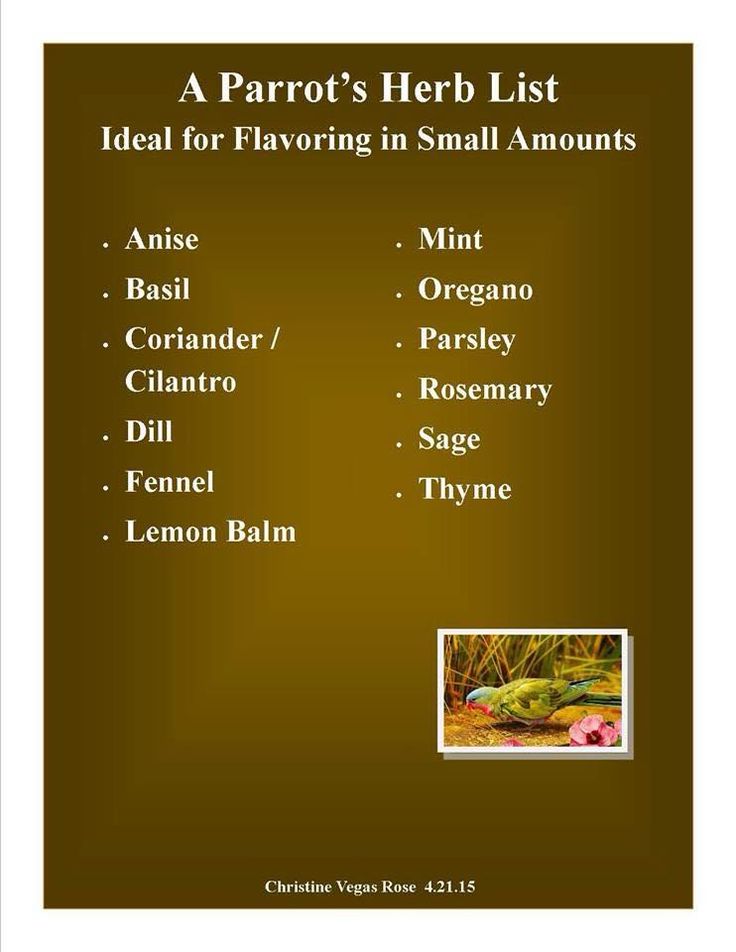 It’ll believe it is in charge if you don’t do this right.
It’ll believe it is in charge if you don’t do this right.
Always stand above your parrot so that it knows you’re in control. Then, encourage it to move onto your finger by placing it against its lower breast. You can begin to add commands such as “step up.”
When your parrot does what you want, reward it with a treat to reinforce the message.
Once you become comfortable around each other, practice laddering with your hands, which involves moving your hand to a higher position while encouraging the parrot to step up onto it.
Don’t Overfeed Treats
If you feed your parrot treats too often, it won’t associate them with training. There’s also too much potential for over-feeding, and your bird may reject its regular food.
Discourage Biting
Parrots should never be allowed to bite or behave aggressively. Biting is different from a gentle nibble, in which your parrot will use its tongue to touch your skin.
Also, many parrots use their beaks to balance and may use human hands to coordinate themselves. If your parrot moves toward your hand, don’t assume it’ll bite you, or it may become nervous.
If your parrot moves toward your hand, don’t assume it’ll bite you, or it may become nervous.
Don’t shout at your bird if you get nipped. Instead, remain calm and say “no” firmly, placing your hand (palm facing forwards) in front of your parrot’s face as a stop gesture.
If your parrot bites you and refuses to let you go, blow on it with a sharp puff of air to make it release. Then, place it back in its cage without a treat.
How To Entertain A Baby Parrot
As parrots spend a significant amount of time in their cage, you must provide entertainment and enrichment to keep your baby parrot mentally and physically healthy. Birds without stimulation can become irritable and destructive.
There’s plenty you can do to keep your parrot occupied, including:
Toys
The first stages of your parrot’s life are crucial to its environmental awareness and development. The bird could grow up with various behavioral problems if it isn’t nurtured.
One of the best ways to combat this is to provide toys such as:
- Puzzles
- Toilet paper for parrots to shred
- Paper sticks
- Chewable objects
- Ladders
- Preening rope
- Bangles
- Building blocks
Putting all toys into the cage at once is impossible, as it’ll cause confusion and take up too much space. Instead, regularly rotate the toys and games to keep your parrot alert and entertained.
Instead, regularly rotate the toys and games to keep your parrot alert and entertained.
Exercises
Let your parrot out of the cage daily for a change of scenery.
Parrots that spend too much time in their cage may become withdrawn and reclusive. Allow them to walk around the house to stretch their legs and wings.
Assign time each day to interact with your baby parrot. This will help you form a bond that the parrot will take through to adulthood.
When your parrot is in its cage, place ladders and other games inside it to encourage your parrot to keep moving, as this will stimulate its mind.
Parrot Playlist
Create a music playlist for your parrot to listen to when you need to leave the house.
Current Biology confirms that parrots can process the sound of music. They also spontaneously move to music, meaning they can dance. A study by Dr. Franck Péron found that Parrots seem to enjoy:
- Pop music
- Rock music
- Folk music
- Classical music
Avoid high-tempo electronic dance music because the same study discovered that parrots subjected to this type of music squawked in distress.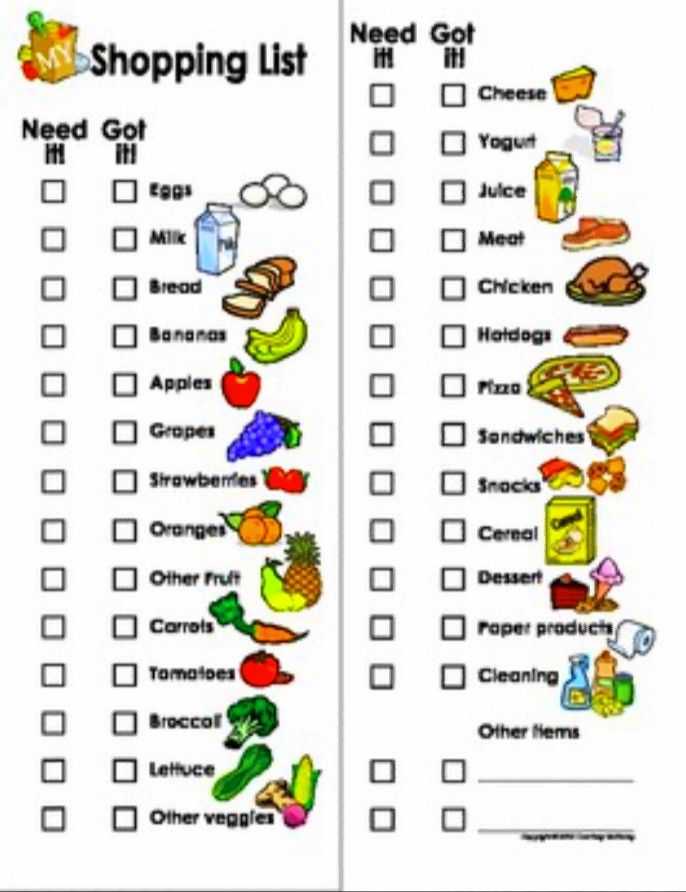
Signs A Baby Parrot Is Sick
Wild parrots avoid showing signs of sickness. Sick birds are the first to be attacked by predators if they sense the parrot is weak and easy to kill. As a result, it’s hard to tell when chicks are unwell.
That said, many symptoms indicate when a parrot is sick:
- Poor feather quality
- Unusually fluffed feathers
- Changes in appetite or eating habits
- Changes to drinking habits; drinking more or less often
- Weakness and lethargy
- Crop not emptying
- Crop not getting full
- Vomiting
- Drooped wings
- Refusal to move
- Increased sleeping
- Inactivity
- Depression
- Bleeding or signs of injury
If you notice one or more of these affecting your baby parrot, take them to an avian vet.
When Can Baby Parrots Leave Their Mother?
In captivity, baby parrots are normally ready to leave their mothers at around 7 to 8 weeks of age. Once a chick hatches, it matures quickly and, once weaned, is ready to leave the nest at around 8 weeks old.
Once a chick hatches, it matures quickly and, once weaned, is ready to leave the nest at around 8 weeks old.
Some breeders prefer to wait until 12 weeks before allowing a baby parrot to go to its new home.
Why Is My Baby Parrot Shaking?
Baby parrots shake and shiver when cold, scared, excited, or sick.
The most common reasons why a baby parrot would shake include the following:
Cold
Baby parrots must be housed in temperatures between 65 and 85 degrees Fahrenheit. The baby parrot will shiver to generate heat if the room is too cold.
A parrot shakes after having a bath. A parrot’s muscles contract involuntarily to generate heat and keep it warm. As soon as the parrot is warm, it’ll stop shivering.
Hot
The parrot will lift and shake its feathers to move cold air around its body to cool itself down. It isn’t technically shivering, but it appears that way.
Scared or Stressed
After moving your baby parrot to its new home, it might shake out of nervousness or stress, especially when it’s away from its mother for the first time.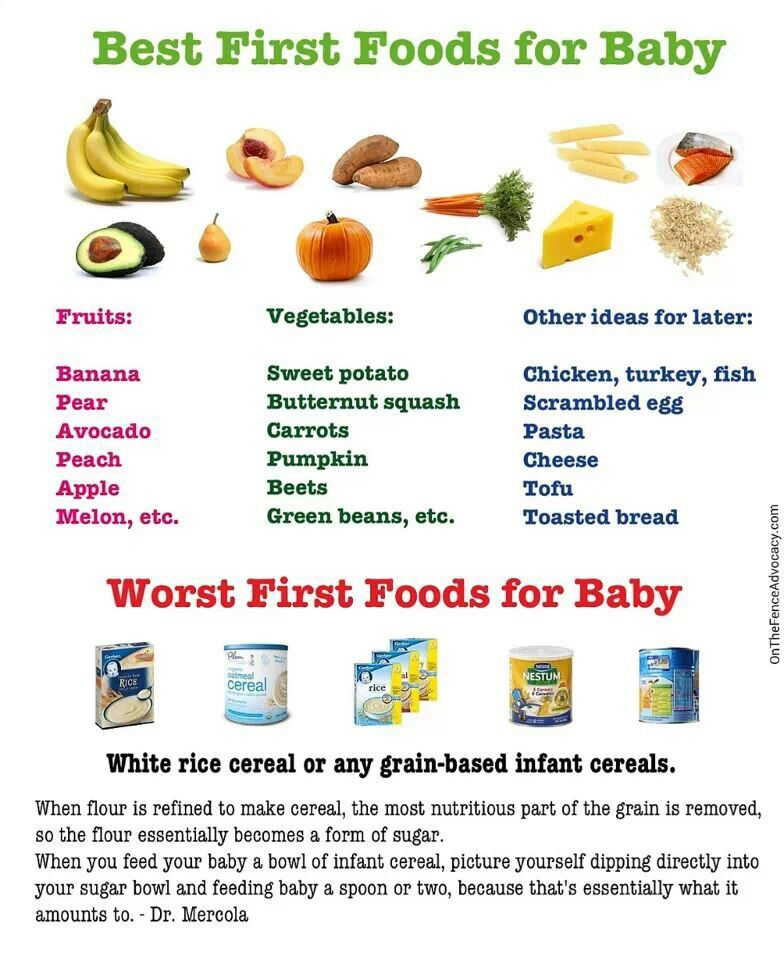
Birds are sensitive to their environments, and small changes can unsettle them.
When around your new pet, speak gently and move slowly to avoid frightening it further. Work on building your bond but move at your parrot’s pace.
Unwell
Baby parrots hide their sickness, so it’s difficult to determine whether they’re unwell. Parrots can’t tell us when they’re ill and rely on us to pick up on it through their behavior and body language.
My Baby Parrot Is Scared of Me
Understandably, baby parrots take a while to adjust, especially after moving to a new environment.
As prey animals, they’re hard-wired to fear their surroundings until they know you don’t pose a threat. Until that time, they’ll be wary and fearful of you.
Some parrots don’t enjoy being handled and never will. Attempting to win your parrot’s trust by touching it more often is unlikely to help and will only make it more scared when you’re nearby.
However, baby parrots are young enough to adjust to your presence if you follow these steps:
- Don’t make any loud noises.

- Let it live in a quiet, neutral room.
- Don’t handle them too often.
- Keep it away from other pets.
- Don’t disturb them while sleeping.
Over time and with care and attention, your baby parrot should start to trust you, allowing you to begin building a bond with your new pet.
What do parrots eat? - ExoticDirect
Is your parrot insured? Get a quote for up to £5,000 of vet fee cover, death and theft cover | We've been insuring exotic pets since 1996 | Check out our customer reviews on Feefo.
Parrots are one of the most popular types of birds, favoured as pets, with commonly owned species including African Greys, Macaws, Amazons, Cockatoos and Alexandrines.
In this article, parrot expert, Dorothy Schwarz, shares her opinion on parrot's diets and shares what has worked for her and her parrots during her many years of experience owning these brilliant birds.
If you're ever unsure, or want further advice, we advise consulting with your vet.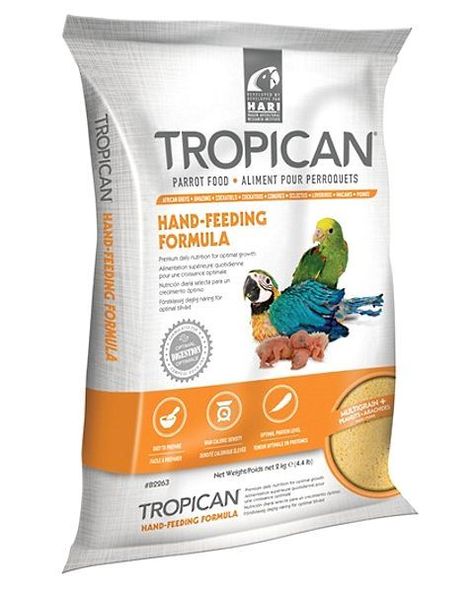
Parrots requires a varied diet. The best foods for your pet parrot to eat are fresh vegetables, fruit and either pellets or seed mixes.
I try to ensure that at least around 40% of my birds diet is fresh fruit and vegetables.
Fruits and vegetables provide an extensive array of vitamins and minerals. Additionally, they are low in fats. Always wash all the produce you feed your bird thoroughly before feeding.
Furthermore, I aim to buy organic fruit and vegetables for my parrots as they contain less pesticides.
There’s debate about whether vegetables are better than fruit for parrots due to the sugar content of fruit.
If you’re unsure about portion sizes and what percentages of various food groups should be fed, consult with your vet as recommended portions vary dependant on the species.
In the wild, parrot's diet can vary considerably and they like to eat fruit and fruit seeds, nuts, flowers, and corn where they can find it.
Table of contents: What do parrots eat? | What fruit and vegetables does a parrot eat? | Wild and foraged foods for your parrot | Parrots and nuts | Commercial seed mixes for parrots | Pellets and your parrot | Supplements and your parrot | Sprouts and beans for your parrot | What do parrots drink? | Home prepared and frozen diets | Exercise and your parrot | Your diet has worked
Fruit parrots can eat
- Apples
- Bananas
- Citrus fruits
- Grapes
- Mango
- Papaya
- Passion fruit
- Pomegranate
- Peaches
Want to learn what other fruit your parrot can eat? View our guide on Safe Food and Plants for Parrots
Vegetables parrots can eat
- Asparagus
- Beets
- Bell peppers
- Broccoli
- Butternut
- Carrots
- Collard greens
- Corn-on-the-cob
- Courgettes
- Hot peppers
- Mustard greens
- Spinach
- Tomatoes
- Leeks
- Winter squashes
- Dandelion greens
- Kale
- Okra
- Sweet potatoes
- Parsley
- Pumpkins
Wondering what else parrots can eat? View our guide on Safe Food and Plants for Parrots.
When getting a new parrot, you may have a little trial and error to understand what fruit and vegetables they prefer.
Any fruit and vegetable from the above list can be tried. Just avoid a lot of mashes or stewed fruit because of fat and sugar content.
What can't parrots eat?
- Avocado
- Eggplant
- Fruit seeds and pits
- Garlic
- Mushrooms
- Onion
- Raw beans
- Raw rhubarb
- Tomatoes
- Whole celery sticks
There are a number of fruits and vegetables you should avoid feeding your parrot. If ever in doubt, always consult with your vet before feeding.
Parrots and protein
Giving parrots a small amount of animal protein is generally accepted. Some vets will forbid eggs; others won’t.
We’d recommend consulting with your vet for their advice if you’re considering feeding your bird eggs.
I’ve fed chicken bones for calcium to my Grey's for almost 20 years.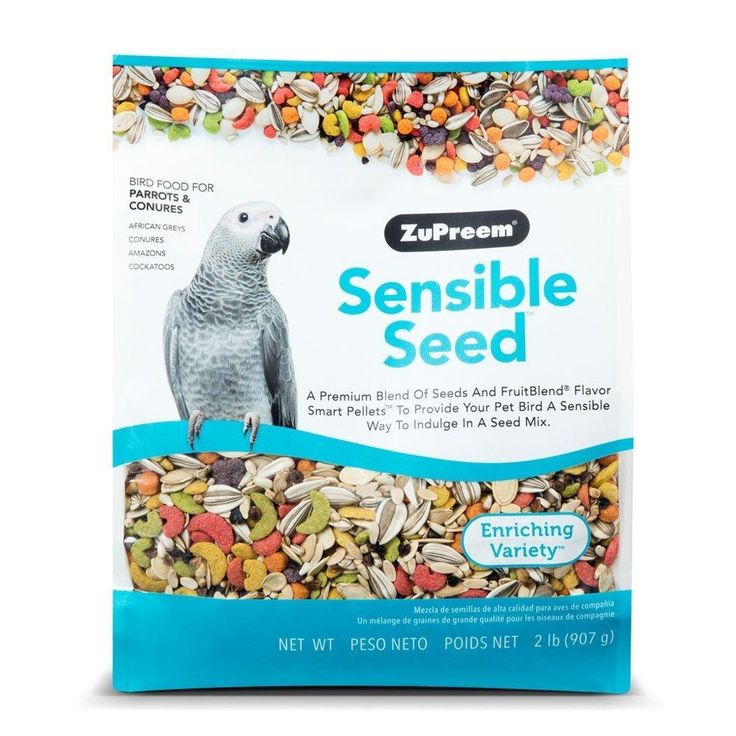 And in persuading my Blue and Gold young Macaw to come to my hand, a chicken bone provided the best lure.
And in persuading my Blue and Gold young Macaw to come to my hand, a chicken bone provided the best lure.
Alongside fruit and vegetables, your parrots also requires either pellets or seeds. Which to feed is debated amongst parrot experts and vets.
Two of my parrots, Casper Grey and Artha Grey were hand reared by their breeder, then weaned onto seed mixture with fruits and vegetables
My vet recommended pellets. His opinion was that non-professional caregivers couldn’t easily make up a good diet with every vitamin and mineral added.
I buy Tidymix. It is costly but so obviously clean. Then I add chopped fruits and vegetables. I sprout legumes and seeds on a three-day rota and everyone gets a portion each day.
I could never switch Casper Grey or Artha Grey to pellets but with the above diet, they're healthy.
Commercial seed mixes for parrots
Seed mixes aren’t a complete diet for parrots, even though they look and smell more appetising than brown nuggets. Bear in mind that the cheaper mixes are dusty and too bulked up with sunflower seeds.
Bear in mind that the cheaper mixes are dusty and too bulked up with sunflower seeds.
Sunflower seeds have a high fat content. They are NOT disastrous for parrots unless they are fed exclusively.
I’ve had the sad experience of two rescue birds dying at 17 and 25, both African Greys. The autopsies showed arteries clogged by an exclusive diet of sunflower.
Part of the issue with sunflower seeds is that their fat content is high which is why they should be fed in moderation - around a dozen a day. This will vary depending on size and species so always consult with a vet if you're unsure.
Some seed mixes now contain a proportion of pellets. Some manufacturers even create seed mixes for specific breeds so it's worth shopping around.
Smaller birds like canaries, finches and budgerigars will naturally consume small seeds or pellets whichever you choose.
Pellets and your parrot
Pellets have been around for 30 years and the present ones are greatly improved on the earlier ones.
Most manufacturers now produce pellets for different species. Many pellet diets have been developed by avian experts. It seems a sensible choice for those of us who are busy out at work.
A word of caution here - you get what you pay for. Cheaper brands contain too many fillers, colourings and chemicals that aren’t the best.
I’ve tried different brands but never managed to get my fussy birds to accept them willingly. You may need to do some trial and error to find a pellet your bird enjoys. Like humans, all birds have their own unique set of taste buds.
Baby birds who are weaned onto pellets appear to accept them more easily.
Changing your parrot from seeds to pellets
If you and your vet decide pellets are the way forward, birds can be taught to transition from seeds to pellets over a few weeks.
Lafaber which are most costly seem to be the most liked natural foods.
Is your parrot insured? Get a quote for up to £5,000 of vet fee cover, death and theft cover with ExoticDirect | We've been insuring exotic pets since 1996 | Check out our customer reviews on Feefo.
Alternatively you can call our team on 0345 982 5505
Wild and foraged foods for your parrot
These are becoming more popular as people learn what wild birds consume. Green fresh garden produce and certain weeds are closer to a wild diet.
If you’re looking at adding new foods such as the below to your parrots diet, make the transition slowly, gradually adding new foods to their diet.
Making a sudden change could upset your bird’s tummy. If you’re ever in doubt, or want further advice, consult with your vet.
Wild foods your parrot can eat
- Chickweed
- Dandelions
- Sow thistle
- Backberries
- Sloes
- Hawthorn berries
- Plantain
- Fat hen plant
- Cotoneaster berries
Some favourites I like to feed my parrot include dandelions. Every part of that coloured weed is beneficial to parrots.
Loro Parc in Tenerife certainly agrees! It’s home to the word’s largest parrot collection.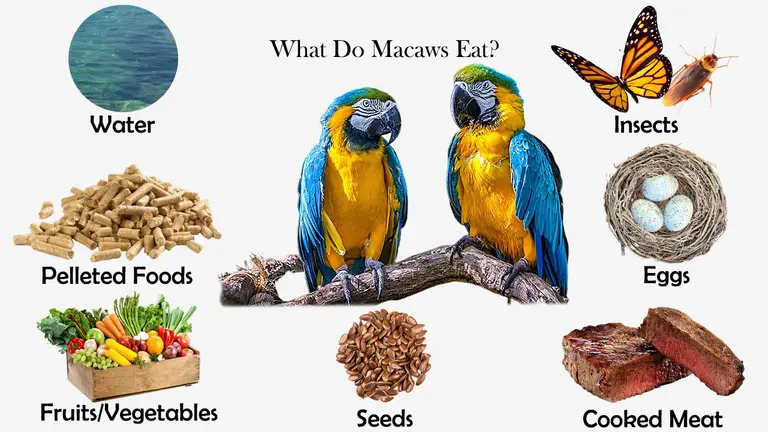 They’re that committed to feeding their parrots dandelions that they devote full plant beds to house dandelions for parrots.
They’re that committed to feeding their parrots dandelions that they devote full plant beds to house dandelions for parrots.
Another favourite I like to feed my parrots are fresh flowers. In the past, I’ve created wreaths from flowers. Perdy, my cockatoo has previously enjoyed a wreath of orange blossom which was so pretty to watch her enjoy.
When feeding plants and flowers to your bird, you need to ensure you thoroughly wash them. You may be able to pick from your own garden however, if you’re unsure of the source, I’d recommend a quick wash in a weak antiseptic solution in case of pollutants.
You need to ensure you’re careful with what you feed to your parrot. We’ve covered some foods you should not feed to your parrot and lists of poisonous flowers and trees are available on the internet. However, if you’re ever in doubt, hold off on feeding a new food to your parrot and consult with your vet first.
You can feed plants such as dandelions to your parrot.
Feeding your parrot nuts
Parrots often love nuts, and as such they make a great treat for training.
You may decline to feed monkey nuts because of the risk of Aspergillosis. (A lung disease with a poor prognosis that is caught from mould). I buy human grade peanuts and and ensure correct storage guidelines and best before dates are being followed.
My aviary houses a small collection of parakeets and rescue parrots who live out in an East Anglian winter. I increase sunflower and monkey nuts in cold weather and have never lost a bird in zero temperatures.
Like legumes, nuts are loaded with protein, but they are also high in fat. Feed your bird all kinds of unsalted nuts, but don’t feed more than a few a day depending on activity.
Recommendations would be one or two nuts a day for most species. More of course for Macaws who have a higher fat requirement.
What nuts can parrots eat?
Parrots can eat: Almonds; cashews; macadamias; pecans; walnuts; brazil nuts; hazelnuts; shelled peanuts; pistachios.
You can also feed your bird peanut butter, as long as you use an unsalted variety.
There are a large variety of peanut butters available now with 100% peanuts as their ingredients so we’d recommend these over anything which contains additional ingredients such as palm oil or any stabilisers. My Artha Grey enjoys peanut butter on toast as a breakfast treat.
What parrots can't eat
We’ve listed what fruits and vegetables your parrot can’t eat but in terms of other foods they can't eat, you must avoid salty, fatty, sugary, fried human foods, tea, coffee and alcohol.
That said I know of many pet parrots (mine included) who adore the occasional slice of prawn cracker or piece of toast or other ‘forbidden’ foods.
Moderation is the key word. Since the birds sometimes join us for dinner, we never serve unsuitable food.
Parrots and poisonous plants
Very few plants are poisonous. Two that come to mind are laburnum and yew. I’m not sure if healthy birds with a good environment will even touch poisonous food.
Is your parrot insured? Get a quote for up to £5,000 of vet fee cover, death and theft cover with ExoticDirect | We've been insuring exotic pets since 1996 | Check out our customer reviews on Feefo.
Alternatively you can call our team on 0345 982 5505
Supplements and your parrot
Supplements of vitamins, probiotics, calcium and other minerals are a consideration. However if feeding a good proportion of pellets you shouldn’t need them.
With non-pelleted diets, opinions are divided. Many breeders add calcium especially for laying hens. My vet believes a healthy diet containing plenty of green stuff obviates the need for supplements.
We’d recommend consulting with your vet as they’ll be able to advise based on what your parrot eats.
Sprouts and beans for your parrot
Germinating and sprouting seeds and selected beans like chick peas and mung beans release valuable nutrients.
Sprouting seeds can be fed on their own or as a part of diets like Shauna’s mash or the circus diet. Sprouting turns a dry seed into a high quality growing vegetable containing fat as energy source. All seeds benefit from sprouting.
The quality of the seeds you use can be determined by the percentage that sprouts. Expect at least 90% to sprout within 3–5 days. Once you get into the habit of sprouting, it’s not that much of a chore. There are commercial sprout mixes. Tidymix do a good one as do Haiths.
Expect at least 90% to sprout within 3–5 days. Once you get into the habit of sprouting, it’s not that much of a chore. There are commercial sprout mixes. Tidymix do a good one as do Haiths.
Two top breeders in Suffolk, Michael Hurley and Barrett Watson use sprouts - beans and legumes as a major diet component and their breeding results are superb.
What do parrots drink?
Wild birds drink water from a variety of sources.
In captivity we need to change water at least once, sometimes twice a day. Some carers use spring water; others swear by addition of a few drips of cider vinegar. That’s my choice also.
Home prepared and frozen diets
The Circus Diet and your parrot
In an interesting development, Steve Hartman’s Circus Diet is well worth looking at and perhaps trying.
As a breeder in USA of over 4,000 birds in 20 years, Hartman has shared his expertise on his website The Parrot University.
Steve believes in pea-sized pieces making it impossible for a bird to avoid any food so their brain is quickly programmed to eat every item. Steve writes: “Once a birds’ subconscious and conscious brain is programmed to eat a large variety of foods, it’s much easier to change their diet.”
Steve writes: “Once a birds’ subconscious and conscious brain is programmed to eat a large variety of foods, it’s much easier to change their diet.”
Portion sizes for your parrot
Steve Hartman recommends the following daily portion sizes:
What to feed a budgerigar? - Sami with Mustache
Most people who have budgies for the first time start out feeding them only grains. But the diet of birds should be varied: you need to include fruits, vegetables and even branches in it.
The second common mistake when feeding a pet is to give him human food, such as cheese or bread.
What products can be included in the pet menu, and which ones can be abandoned forever, we will consider in this article.
Grain mixtures
Cereals are the basic food for birds. This is the easiest answer to the question of how to feed a new friend.
Grains normalize the work of the digestive tract. Make sure your pet has constant access to food.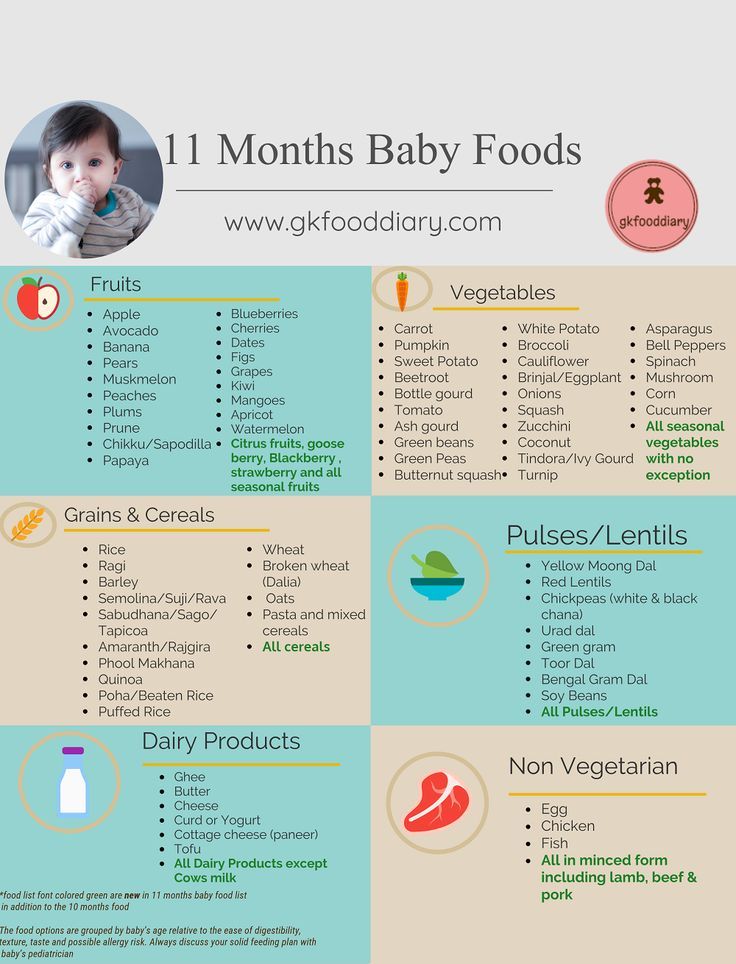
You can buy grain mixture at the pet store or make your own. The food is available in transparent and opaque packages. The advantage of the former is that you see the composition and quality.
In the second case, it is worth buying from trusted manufacturers. Grains must be sold in vacuum bags.
The best option is to make your own mixture. Optimal ratio of grains (in percent):
- yellow millet - 50;
- red millet - 25;
- white millet - 15;
- shelled oats - 10.
It is necessary to monitor the state of the mixture. If she has grown old, mold has appeared or bugs have started, you can’t feed the parrot with this.
The healthiest fruits and vegetables for parrots
Budgerigars' favorite treats are fruits and vegetables. They contain vitamins, trace elements and fiber, which are necessary for birds. It is recommended to add these products to their menu all year round.
- Cabbage. The main vegetable for a parrot in winter. It is stored for a long time, contains many useful trace elements. Give the leaves raw, without the stalk. Broccoli, white cabbage or Beijing cabbage are allowed.
- Carrot. Cut into small pieces or rubbed on a grater. Use only fresh vegetables. Bird from carrots receives vitamin C and beta-carotene. You can mix carrots with other vegetables.
- Cucumbers. Helps to better assimilate the rest of the products. Quench thirst, contain vitamins E, microelements.
- Tomatoes. In the summer season, be sure to include them in the bird's diet. Tomatoes contain vitamin B, ascorbic acid. Give the pulp only ripe fresh fruits. Unripe tomatoes are contraindicated for birds.
- Beets. Contains a large amount of antioxidants. It, like cabbage, is given raw all year round. In addition to saturating the bird's body with vitamin A and C, beets normalize digestion.
Zucchini is a storehouse of fiber. Be sure to give it raw. Helpful for proper bowel function.
Be sure to give it raw. Helpful for proper bowel function.
From fruits and berries, you can give a feathered pet:
- bananas,
- apples,
- pears,
- peaches,
- pineapples,
- kiwi,
- citrus fruits,
- pomegranate,
- cherry,
- raspberries,
- strawberries,
- strawberries.
In summer, the parrot can be fed with melon and watermelon.
Fruits and berries must be peeled and pitted. Cut large fruits into pieces. In winter, fresh fruits are replaced by dried fruits, such as raisins or dates.
And now let's take a closer look at the vitamin and mineral composition of fruits:
- Bananas are rich in potassium. This microelement is necessary for pets as well as people.
- Apples contain many vitamins and enzymes useful for poultry. The use of these fruits normalizes the digestive system. It is advisable to give them every day.

- Pear contains pectin, carbohydrates, iron and phosphorus. Thanks to it, the pet's body is saturated with minerals, energy, and the digestion process improves. When choosing, give preference to hard fruits.
- Peaches improve digestion, contain copper and iron. These fruits are given to weakened birds to stimulate their appetite.
- Pineapples strengthen the muscular and vascular systems. It is recommended to give in canned form.
- Give kiwifruit to pets during beriberi (end of autumn, winter, beginning of spring). The fruit will strengthen the immune system and protect against diseases.
- Pomegranates will ensure the healthy functioning of the budgie's cardiovascular system. The maximum daily allowance reaches 1/6 of the fruit. A few grains are enough for a bird.
- Of the citrus fruits, oranges are recommended: they contain carbohydrates, fiber, and antioxidants. Like kiwi, a great immune boosting food.
It is worth refraining from persimmons, mangoes, papaya and avocados. What harm they bring to birds, we will understand further.
What harm they bring to birds, we will understand further.
Herbs and greens
Some types of greens can harm the pet's body. Do not give him parsley, dill and green onions. It is strictly forbidden to feed the budgerigar with tomato tops.
Will bring benefits:
- horse sorrel,
- arugula,
- celery,
- plantain,
- clover leaves.
Wild plants cannot be collected near the roadway.
Do not let the parrot peck at houseplants and bouquets - they are toxic to the bird.
Twigs of trees - how to give?
If you have had parrots before, you probably know how they love to “nibble” everything. Therefore, it is worth placing branches of fruit trees in a cage. They will be both a toy and food.
Choose trees away from roads, industrial areas. Check the branches for resin.
After pruning, the branches are soaked in water for 4 hours, washed and doused with boiling water. Branches of what plants can be given to a parrot?
Branches of what plants can be given to a parrot?
- apple trees,
- birches,
- willows,
- rowan,
- viburnum,
- sea buckthorn,
- hazel.
You can also cut a bush of currants, raspberries.
Kashi
Porridge will give the parrot the necessary minerals, normalize metabolism. When cooking, only water is used, without the addition of oil, salt, sugar. Do not use instant cereals.
Cook for your pet only from high-quality buckwheat, oatmeal, lentils, barley. Grains should be boiled for 10 minutes.
You can also give rice and wheat porridge. Their cooking time is 20 minutes.
Germinated sprouts
It is necessary to include sprouted grain in the diet of a parrot so that its body receives vitamins E and B2.
How to cook sprouts at home?
- Fill the bottom of a deep dish with grains, fill with water to cover them a little.

- Change fluid every 4 hours and rinse beans.
- After a few days, sprouts will appear. For a parrot, a shoot up to 2 mm in height is enough.
- The sprouts are dried before being given to the bird.
Before the first molt, small chicks are given 1 tsp. sprouts 2 times a week. Then once a month.
Mineral additives
The key to feeding a parrot is mineral supplements. For example, a bird will benefit from feed chalk saturated with calcium. You need to buy special chalk for birds, because intended for rodents can harm the health of a parrot. Other sources of minerals:
- Combined mixtures. Those sold in pet stores contain a 70:30 ratio of shell rock to chalk. Manufacturers often add small amounts of eggshells and charcoal to them.
- Stones. They come with iodine, iron, zinc, magnesium and calcium. These elements are responsible for the health of the skeleton, endocrine glands.
- Sepia (cuttlefish shell).
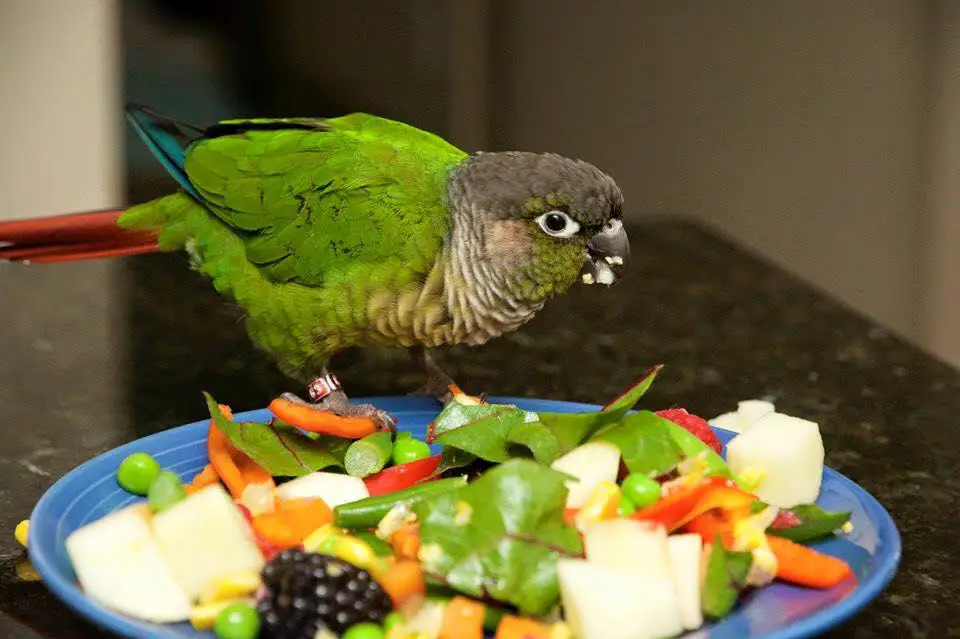 Rich in Na, K, Mg, P, which protect the beak from deformation. Give preference to sepia white with a slight yellow tinge.
Rich in Na, K, Mg, P, which protect the beak from deformation. Give preference to sepia white with a slight yellow tinge. - Organic sand. Consists of crushed shells. Promotes the grinding of food in the goiter.
- Chicken eggshell. Due to the content of potassium, it strengthens the skeleton, creates a protective layer of the shell when laying eggs
- Birch charcoal. Storehouse of calcium and iron. It will be a detox for your pet.
Large solid minerals are attached to the bars of the cage, the mixture is poured into a plate.
Rehydration for parrot
Water is an essential element for all living things. When caring for a pet, make sure that the water in the drinking bowl is clean and fresh.
Change fluid every day. Its temperature should be 15-20 degrees. It is better to pour water in small portions.
However, water is not the only way for a parrot to replenish its water balance. There is another one - juicy fruits, vegetables and grass. He receives part of the necessary liquid from these products.
He receives part of the necessary liquid from these products.
Periodically, to protect against a fungal infection, the parrot is given water with 2-3 drops of lemon vinegar or lemon juice. This amount is calculated for 100 ml of liquid.
Juices are useful for birds, but only cooked at home. From the list of allowed fruits and vegetables, prepare freshly squeezed juices. They can be diluted with water.
Natural products spoil quickly - make sure that the juice does not ferment, otherwise it will harm the pet.
Prohibited products for budgerigars
In some sections of the article, products that are prohibited for parrots have already been mentioned. In addition to them, you can not give your pet:
- salt and sugar;
- nuts of any kind;
- seeds and stones of certain fruits and berries;
- onion and garlic;
- meat products, fish;
- mushrooms;
- coffee, tea;
- dairy products;
- soda;
- alcohol;
- chips, crackers and other fast food.

For chicks aged 3 to 4 months, a boiled egg and cottage cheese are added to the diet. After the first molt, these products are excluded.
The most dangerous foods for a budgerigar that can lead to his death are avocados, alcohol, chocolate and salt.
Let us consider in more detail why it is forbidden to give the rest of the products from the list.
Herbs such as dill and parsley are high in essential oils. These substances, toxic to the bird, eventually lead to disruption of the functioning of its internal organs.
Opinions differ on spinach. It contains a large amount of oxalate, which binds calcium and other trace elements. Because of this, useful substances are not absorbed, and oxalates are deposited in the form of kidney stones.
Spinach can be given to birds with healthy organs, but in a minimal amount. If in doubt whether your pet has kidney problems, refrain from this greenery.
It is imperative to peel and pit fruits and berries: apple, pear, and cherry seeds contain cyanide, and pesticides accumulate in the skin of fruits.
Fresh onions and garlic can sometimes be given to your pet as a prophylaxis against parasites and fungi. But in small quantities. Excessive consumption of these vegetables will lead to hemolytic anemia, and subsequently to the death of the animal.
Coffee and tea contain caffeine, an overdose of which will cause a bird to have a heart attack. This is also the danger of energy and carbonated drinks.
If your parrot is sick, feels weak, it is permissible to give him weak tea: the drink will have a tonic effect.
Mushrooms cause indigestion, and some of their species - liver failure.
Finally, a few more restrictions:
- The nuts are too fatty.
- Sorrel causes kidney problems.
- Mango and papaya are supplied unripe and therefore contain toxic substances.
The body of a parrot is designed to digest grains, tree bark, fruits and berries. If your pet gets all this, he will be healthy and cheerful.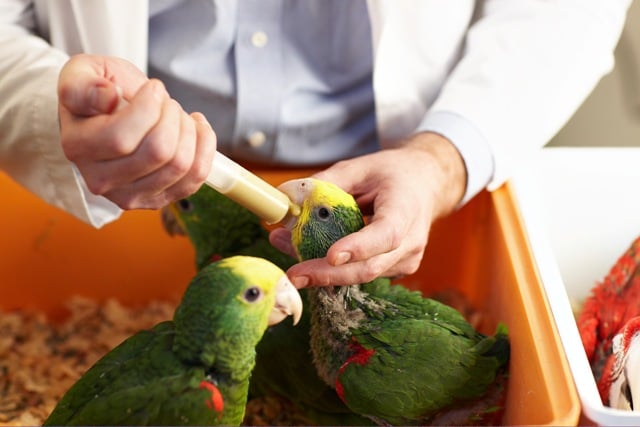
How to feed a budgerigar at home?
Contents
one Corn 2 Vegetables 3 Greens four Fruit
4 minutes
estimated reading time
Budgerigars are amazingly beautiful birds that are unpretentious and do not require complex care. The most important thing is to organize the right diet, because their health will depend on it!
What to feed budgerigars? The choice of "dishes" for the pet is varied.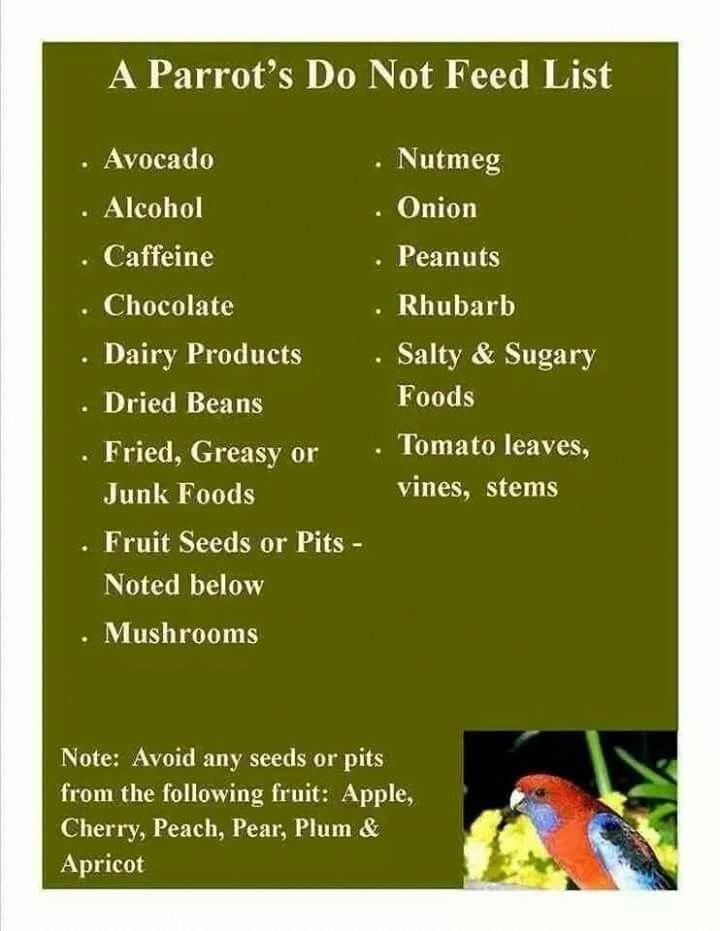 They love vegetables, fruits and herbs, but grains are the basis of the diet.
They love vegetables, fruits and herbs, but grains are the basis of the diet.
- Grain
Almost any pet store sells special grain mixes for parrots. It is better to choose food in transparent packaging, so you can evaluate the quality. And from opaque packages, you need to choose those in which the grains are stored in a vacuum (without air and other gases). Otherwise, be prepared for the fact that the products may not be of the best quality or even moldy.
If you want to combine food yourself, use only high-quality millet and oats. Grains are the basic food for birds, they determine the proper functioning of the digestive system, so the pet should always have access to them. The following ratio is recommended:
- yellow millet - 50%;
- red - 25%;
- white - 15%;
- oats (peeled) - 10%.
In the process of determining what to feed a budgerigar at home, one must remember that sprouted grain must be included in the diet: it contains useful vitamins E and B2. You can easily cook it yourself. To do this, put the grains on the bottom of the container (in one layer) and pour warm water so that it covers the grains a little. It will be great if you can renew the liquid in the container and rinse the grain every four hours. After a couple of days, sprouts will be visible, they will be tiny - only 2 mm in length, but it is at this stage that the grains are most useful for parrots. Rinse and dry before feeding.
You can easily cook it yourself. To do this, put the grains on the bottom of the container (in one layer) and pour warm water so that it covers the grains a little. It will be great if you can renew the liquid in the container and rinse the grain every four hours. After a couple of days, sprouts will be visible, they will be tiny - only 2 mm in length, but it is at this stage that the grains are most useful for parrots. Rinse and dry before feeding.
Make sure that they do not become moldy and do not overgrow, as such sprouts lose their valuable properties.
What else can you feed a budgerigar? First of all, these are vegetables, fruits and herbs. Often young birds are wary of such food, but if you cut vegetables and fruits into small pieces or pass them through a grater, your pet will definitely appreciate them!
Before feeding, be sure to rinse the fruits and greens with running water!
- Vegetables
Parrots love them very much, and still: it is tasty and healthy! They contain many vitamins and minerals, as well as fiber, so you should include such foods in your diet throughout the year.
Vegetables such as carrots, fresh cucumbers, tomatoes, beets, zucchini, etc. will be useful for your pet. You can also feed parrots with turnips and various types of cabbage, but first you need to pour boiling water over them.
- Greenery
Do not feed dill, green onions, eggplant, tomatoes, potatoes, etc. to birds - these greens are harmful to them!
When you are planning the best food for your budgerigar, be careful with the parsley. It only works in small quantities. But horse sorrel, arugula, celery (not roots), tops of carrots and radishes can and should be included in the diet! In the summer, pamper the birds with strawberries (both berries and leaves will go with a bang), plantain, clover leaves and flowers, etc. Plants for feeding a parrot should be collected away from roads and factories, in areas with clean healthy soil.
Spinach can also be added to the diet, but not much, and if the bird does not have kidney pathology.
If your house has indoor plants or flowers in bouquets, do not let the parrot eat them: they are dangerous!
So that the pet does not lack greenery during the winter months, you can grow cereals and vegetables at home right on the windowsill. It's easy and the benefits are huge!
- Fruit
Among other things, feed budgerigars at home should be fruits and berries. It is recommended to include in the diet bananas, apples and pears (the seeds and the core must first be removed), peaches, pineapples, kiwi, peeled oranges, tangerines and lemons, as well as some grapes. Of the berries, pitted cherries, raspberries, strawberries, strawberries will be useful. You can also feed melon and watermelon to your pets, but it is better in the summer season.
In the winter months, include dried fruits in the parrot's diet: raisins, dried apricots (steamed), dates, etc., as well as frozen berries, for example, lingonberries and blueberries are useful.
You can not feed the birds persimmons, mangoes, papaya, avocados, as well as any nuts!
You can already see how varied the diet is, but that's not all! They will be happy to taste porridge, boiled or steamed in boiling water. It should be cooked only on water, you can not add oil, salt and sugar. Use only high-quality cereals, and never feed your parrot instant porridge, which contains additives that are harmful to birds.
The last key point on the question of what you can feed budgerigars is mineral supplements, which should always be freely available in the pet's cage. So what is it like and what is its use? For example, chalk saturates the body with calcium, mineral stones containing iodine and seaweed provide useful trace elements, sepia is used by parrots to sharpen their beaks, organic sand allows you to control the state of the digestive system (it should be given no more than once a week), etc.
Choose only special quality top dressings and in no case use inorganic sand, this will harm the bird!
Ready-made quality balanced food for budgerigars is another way to organize the ideal diet.





